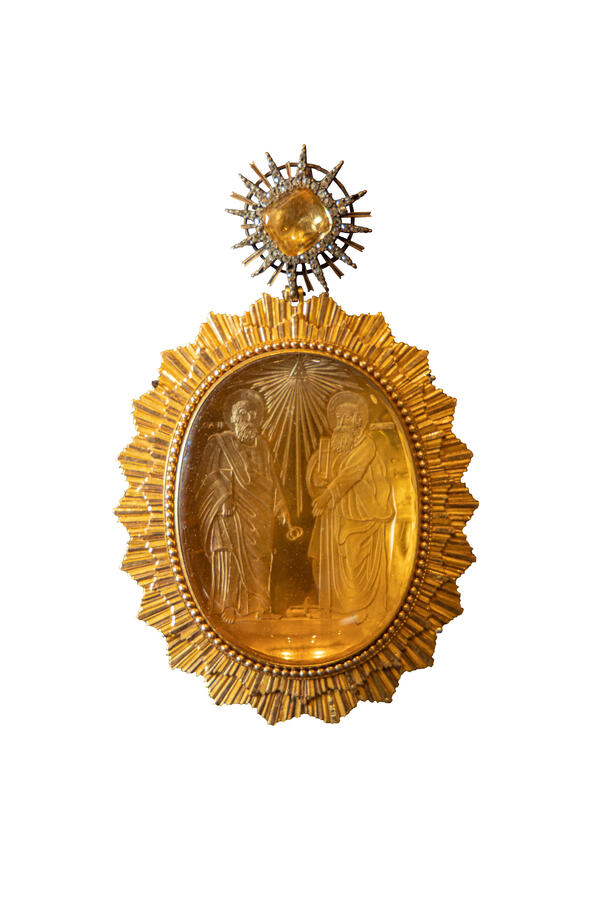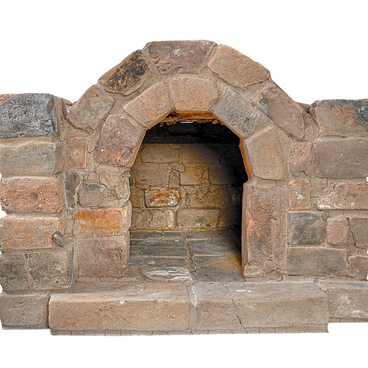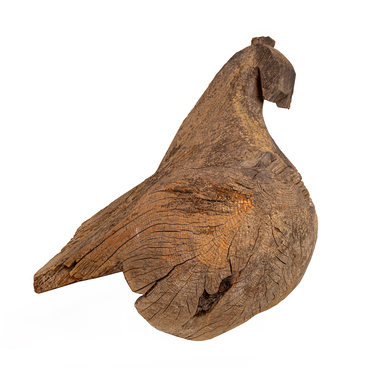The Panhagia is a small chest icon on a chain worn by bishops. On the back, as a rule, there was a small ark, closed with a lid: a recess for the relic.
The Panhagias were richly decorated, and they were often presented as a gift. This exhibit was created in 1797 for the sixtieth anniversary of Metropolitan Platon (Levshin), named Peter in Holy Baptism, and the accession to the throne of his pupil, Emperor Pavel Petrovich.
The initials of the owner are engraved on the reverse side of the panhagia: “MPAL” (Metropolitan Platon Archimandrite of the Lavra) and his motto: “Glory to God for everything.” Later, another inscription appeared: “From Metropolitan Platon to Archbishop Augustine of Moscow in 1807.” It was made when the sign was presented to the metropolitan’s disciple and vicar (bishop who does not have his own diocese) Augustine Vinogradsky.
In 1858, the niece of Archbishop Augustine A. Solovyova transferred panhagia to the Trinity Lavra of St. Sergius in memory of the Trinity Archimandrites. The rank of archimandrite appeared in the Orthodox Church in the 4th-5th centuries. So they called the people who looked after the monasteries of the diocese. Subsequently, the name “archimandrite” passed to the heads of important monasteries, and then to the monks who held church administrative positions.
The shape of this panhagia resembles an order badge. In the center is a huge yellow quartz, polished to shine, with figures of the preeminent apostles Peter and Paul carved on the inside of the stone. A similar artistic method of carving was common in Byzantine and Russian medieval art.
Apostle Peter is represented with keys, and Apostle Paul with a sword lying at his feet. Such subject is not typical for traditional iconography. This image recounts an event during the coronation. Emperor Paul I wanted to enter the Holy Gates to receive the Holy Communion, with a sword on him, but Metropolitan Platon stopped him, saying: “A Bloodless Sacrifice is being offered here, take away, most pious sovereign, the sword from your thigh.”
The upper part of the panhagia is made in the form of a star with diamond rays around a golden topaz.
The Panhagias were richly decorated, and they were often presented as a gift. This exhibit was created in 1797 for the sixtieth anniversary of Metropolitan Platon (Levshin), named Peter in Holy Baptism, and the accession to the throne of his pupil, Emperor Pavel Petrovich.
The initials of the owner are engraved on the reverse side of the panhagia: “MPAL” (Metropolitan Platon Archimandrite of the Lavra) and his motto: “Glory to God for everything.” Later, another inscription appeared: “From Metropolitan Platon to Archbishop Augustine of Moscow in 1807.” It was made when the sign was presented to the metropolitan’s disciple and vicar (bishop who does not have his own diocese) Augustine Vinogradsky.
In 1858, the niece of Archbishop Augustine A. Solovyova transferred panhagia to the Trinity Lavra of St. Sergius in memory of the Trinity Archimandrites. The rank of archimandrite appeared in the Orthodox Church in the 4th-5th centuries. So they called the people who looked after the monasteries of the diocese. Subsequently, the name “archimandrite” passed to the heads of important monasteries, and then to the monks who held church administrative positions.
The shape of this panhagia resembles an order badge. In the center is a huge yellow quartz, polished to shine, with figures of the preeminent apostles Peter and Paul carved on the inside of the stone. A similar artistic method of carving was common in Byzantine and Russian medieval art.
Apostle Peter is represented with keys, and Apostle Paul with a sword lying at his feet. Such subject is not typical for traditional iconography. This image recounts an event during the coronation. Emperor Paul I wanted to enter the Holy Gates to receive the Holy Communion, with a sword on him, but Metropolitan Platon stopped him, saying: “A Bloodless Sacrifice is being offered here, take away, most pious sovereign, the sword from your thigh.”
The upper part of the panhagia is made in the form of a star with diamond rays around a golden topaz.



